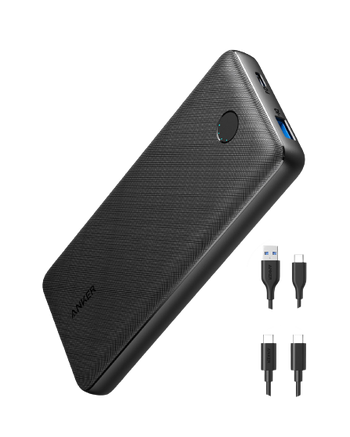- Supports fast charging
- High capacity
- Can charge laptops
- Safety features for secure charging
- Highly portable
- Lightweight
- Optimized charging speeds
- Affordable price
- Slightly heavy
- Pricier than basic models
- Lower capacity
- Single output port
Anker PowerCore 20000 PD vs Anker PowerCore 5000
When it comes to staying powered on-the-go, Anker portable chargers are a popular choice among consumers. Two of their notable products are the Anker PowerCore 20000 PD and the Anker PowerCore 5000. While both devices share some similarities, they also have distinct differences that set them apart. In this comparison, we'll delve into the features, performance, and value of each product to help you decide which one best suits your needs.
Capacity and Size
The most obvious difference between the two products is their capacity. The Anker PowerCore 20000 PD has a massive 20,000mAh battery, while the Anker PowerCore 5000 has a relatively smaller 5,000mAh battery. This means that the former can charge your devices multiple times, making it an ideal choice for extended trips or heavy users. On the other hand, the latter is more suited for casual use, providing a single full charge for most smartphones.
In terms of size and weight, the Anker PowerCore 20000 PD measures 6.3 x 3 x 0.9 inches and weighs around 12.8 ounces, making it slightly larger and heavier than the Anker PowerCore 5000, which measures 4.1 x 2.5 x 0.9 inches and weighs around 6.3 ounces. While neither device is excessively large, the smaller size of the Anker PowerCore 5000 makes it easier to carry in a pocket or purse.
Charging Speed and Technology
Both devices feature Anker's proprietary charging technology, which provides fast and efficient charging for your devices. However, the Anker PowerCore 20000 PD has an edge when it comes to charging speed, thanks to its support for USB-C Power Delivery (PD). This allows it to charge compatible devices like laptops and tablets at speeds of up to 18W, making it a great option for users who need to top up their larger devices on the go. In contrast, the Anker PowerCore 5000 has a maximum output of 12W, which is still respectable but not as fast as its larger counterpart.
Ports and Compatibility
The Anker PowerCore 20000 PD has two USB-A ports and one USB-C port, allowing you to charge multiple devices simultaneously. The USB-C port also serves as an input for recharging the power bank itself. On the other hand, the Anker PowerCore 5000 has a single USB-A port and a micro-USB input port for recharging.
In terms of compatibility, both devices can charge a wide range of devices, including smartphones, tablets, and wearable devices. However, the Anker PowerCore 20000 PD's support for USB-C PD makes it more versatile and future-proof, as more devices begin to adopt this standard.
Price and Value
The Anker PowerCore 5000 is generally priced lower than the Anker PowerCore 20000 PD, making it a more affordable option for casual users. However, considering the larger capacity and faster charging speeds of the Anker PowerCore 20000 PD, it's arguably better value in the long run, especially for heavy users who need to charge their devices frequently.
Conclusion
In conclusion, both the Anker PowerCore 20000 PD and the Anker PowerCore 5000 are excellent examples of Anker portable chargers, offering reliable and efficient charging solutions for your devices. While the former is better suited for heavy users and those who need to charge larger devices, the latter is perfect for casual use and provides a compact, lightweight design.
Ultimately, the choice between these two products depends on your specific needs and preferences. If you prioritize capacity, speed, and versatility, the Anker PowerCore 20000 PD is the better choice. However, if you're looking for a more affordable, compact option that still provides reliable charging performance, the Anker PowerCore 5000 is an excellent alternative.































